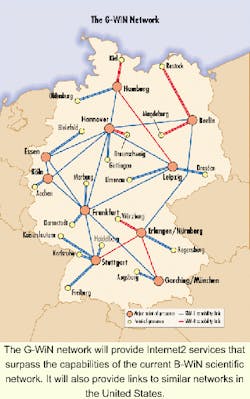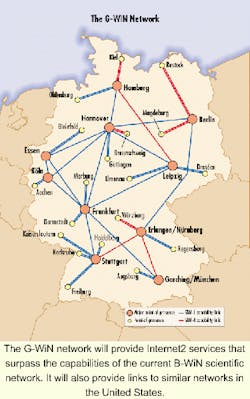Germany's G-WiN network leaps into Internet2 future
Under the banner headline "A Leap into the Future," the German Re search Network (Deutsches Forsch ungs netz-DFN) was demonstrated at the recent CeBIT 2000 show in Germany. The DFN-Verein has embarked on the first stage of constructing the Internet2 in Germany. Its pilot runs of two Gigabit Testbeds-West and South/Berlin, both successfully completed in February 2000-have clearly revealed the shape of a new ultra-high-speed data network for science, research, and education in Germany.
New ultra-high capacity in transmission rates provided by Deutsche Telekom will open the data network to an ever-expanding range of applications:
- Video servers for network transmission of TV-quality educational material.
- Operations planning and execution with partners connected by data lines (DFN is a consortium of German research institutes that share a core network across Germany).
- Mainframe simulation/visualization for a deeper comprehension of real-world effects.
- Live Internet linkups for direct communications between partners all over the globe.
One of the first application spaces to benefit from the new Internet2 is the G-WiN network, a computer-assisted communications infrastructure for science and research that assures a wide range of communication services, including access to the worldwide Internet. Lucent and Alcatel will be delivering the necessary core-transmission network for Deutsche Telekom later this spring.
The 2.5-Gbit/sec G-WiN will replace the older B-WiN broadband research network, which currently provides the backbone to the DFN-Verein infrastructure. More than 700 organizations in Germany now have a link to B-WiN with lines of up to 155 Mbits/sec. As of last month, the data-traffic volume was expected to be approximately 200 Tbytes per month. G-WiN deployment will be extended to normal schools and other public institutes to link with the scientific communication network using a simple modem or Integrated Services Digital Network.
With the complex, cross-boundary nature of the future G-WiN network and the German Internet in view, DFN-Verein launched the first gigabit testbed pilot projects in collaboration with the Federal Ministry for Education and Scientific Research. This German ministry has granted a financial package of DM85 million for the construction of G-WiN, which consists of the regional linkup systems, routers, and a link to Internet2 facilities in the United States (see Figure).
DFN-Verein opened the tender for Synchronous Digital Hierarchy and dense wavelength-division multiplexing (DWDM) network provision to a Europe-wide call for tender for the construction of the G-WiN in April 1999. Deutsche Telekom was awarded this contract and intends to use its new DWDM transmission network that Lucent and Alcatel are currently building.
In the initial phase, the extension of the Deutsche Telekom net work focuses on the needs of G-WiN, which was scheduled for operation in April.International data linkups are a major part of computer-aided communica tion in the academic, re search, and education communities in Ger many. Since late Oct ober 1999, DFN-Verein has been op erating four links with an overall cap acity of 610 Mbits/ sec to a location in New York. "DFN-Verein has a cooperation with the Europ ean Network Organi za tion DANTE in Cam bridge, Engl and. It has engineered a direct New York linkup to the Abilene net of the Internet2 initiative of the UCAID [The Univer sity Corporation for Advanced In ternet Development], ex plains Dr. Gudrun Quandel of DFN-Verein. "This direct linkup is the key factor underpinning the cooperation of European research networks and the UCAID in their common effort to create the next Internet generation."
Edward Harroff writes on telecom issues from Bellevue, Switzerland.

